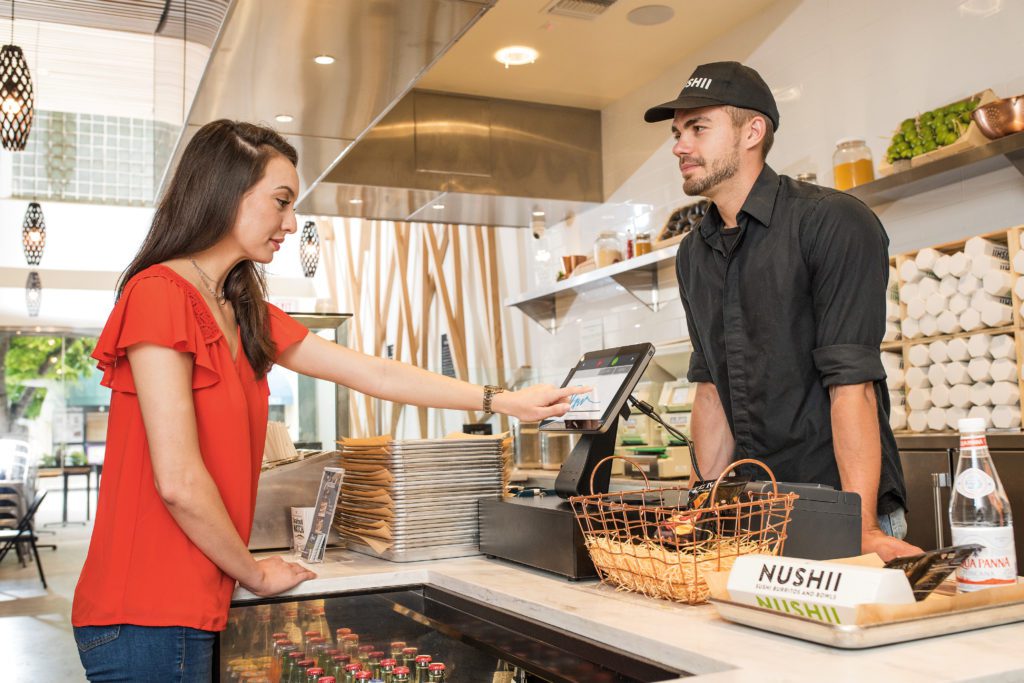Whenever we get around retail industry pros, innovators or trendsetters we try to pick their brain to glean a little insight into what’s happening in the trenches. We recently spoke with Luke Wilwerding, Director of North America Sales at Elo, to get the scoop on what he sees as the future of point of sale software and hardware.
 How does the POS of the 1990s compare to what we’re seeing today?
How does the POS of the 1990s compare to what we’re seeing today?
Advances in technology in the retail industry have significantly changed the POS, which means things are now a little different when people are choosing a point of sale system. Today, shoppers require easy accessibility, efficiency, and an ‘experience.’ Traditional brick-and-mortar stores are achieving this is through the incorporation of digital touchscreen POS solutions for self-service ordering and checkout, which represents a paramount shift in the checkout experience. Enhancements in technology have freed the POS from behind the counter and into the hands of shoppers and diners, creating multiple new touchpoints within a store or restaurant. This has rapidly improved efficiency and sped up the purchasing process. The various form factors of digital touchscreens enable new opportunities for upselling and cross-selling that simply weren’t available a few decades ago.
Retail Industry Insight: Technology has set the POS free from the cash wrap.
Is there still a need for traditional POS in today’s retail stores? Thoughts for the year 2023?
While there are still businesses that rely on traditional POS in the retail industry, they’re missing out on the immense benefits of digital touch solutions. However, the type of technology they choose to install should depend on the store, the products it sells, and the needs of their customers. While self-service kiosk POS terminals can allow shoppers to browse online inventories and offer a host of other benefits, not every store needs a large kiosk installment. Smaller boutiques may opt for digital signage with POS capabilities instead, so they can still obtain the benefits of digital checkout without making a significant investment. Regardless of form factor, I predict all POS will soon have a customer-facing digital touchscreen component to serve the changing landscape of analytics, loyalty, payments and service offering options.
Today, retailers and restaurant managers are being tasked to offer memorable “experiences” while also blending their online and in-store channels. Soon, they may also face a new challenge of changing the way they actually charge their customers for their products and services. Society is shifting to ‘cashless’ payment and within a few years the move to ‘contactless’ payment will be upon us. By 2023, we should expect contactless payment to become more widespread, especially as tech-savvy consumers are beginning to expect a certain high-touch experience when they shop or dine out.
Retail Industry Insight: Cashless and contactless payments are here to stay.
How important is brick-and-mortar to the retail/restaurant experience? How has this changed since 2000 and where do you think it will be in 5 years?
Reports on the ‘retail apocalypse’ have been plaguing headlines for quite some time now, but many of these stories are exaggerated. In fact, a report from eMarketer forecasted ecommerce spending will account for about 10 percent of US retail sales by 2019, meaning that 90 percent of purchases are still going to be made in physical stores. Smart retailers understand that it’s not about focusing solely on the in-store experience versus ecommerce – it’s about blending the two together to cater to the growing number of multichannel buyers (shoppers that use both online and in-store resources to make purchasing decisions). Over the next five years, we should expect to see more stores and restaurants integrating touchscreen solutions in-store enabling shoppers to browse available inventory, make purchases from their website or app, and view options that may be available online-only. This will help shoppers know about the latest product release or to not miss a sale by bridging their purchasing channels.
Retail Industry Insight: Expect more touchscreen solutions to appear in stores.
What are Elo’s POS solutions? How do they address the challenges retailers are experiencing with their traditional POS?
Elo offers retail industry-leading POS systems, touchscreen computers and displays from 10- to 70-inches, and mobile tablets that can be customized to fit the needs of businesses based on the objectives they’re trying to achieve (whether that be increased order accuracy, streamlined operations, or increased sales). The systems are built to last and withstand repetitive impact from demanding environments and can be easily upgraded with snap-in accessories like card readers, EMV payment, near field communication, scanners, and more. The POS terminals are designed to give power to both the employee and the consumer with customer-facing displays creating a unique digital experience enabling opportunities for upselling and loyalty while transactions are being made. In addition to our innovative product designs, we work with retail industry-leading software and hardware partners, like Mainstreet, to make it easy to add cash drawers, scanners, receipt printers and a full suite of services.
Retail Industry Insight: Elo designs terminals to empower employees and consumers.
What sets Elo’s POS solutions apart from its competition?
Elo distinguishes itself by offering unique POS systems that are well-suited for the rigors of a wide range of public venues. Our versatility of product offerings enables our customers to be innovative as they explore new ways to engage in-store now and in the future. More recently, Elo announced the new Wallaby™ Self-Service Stands making both countertop and floor placement in restaurants or retail settings easy. Elo also recently launched PayPoint® Plus for iPad® and PayPoint® Plus for Android™. The all-in-one mPOS solutions bring unmatched style with a distinctive, modern aesthetic. These systems provide everything a merchant needs, including a fully integrated 2D barcode scanner from Honeywell, a 3-inch printer from Star Micronics, and encryptable MSR from Magtek. A full-sized cash drawer, connections for third-party peripherals, a flip-for-signature touchscreen, and (on some configurations) a built-in customer-facing display can be integrated, too. These POS systems, in addition to others from our product line, are ideal for a variety of verticals, including general retail, specialty, salons, quick-serve, casual dining, cafes, grocers, hotels, stadiums, and other entertainment venues. Due to this, we can work with restaurants and retailers in just about every industry to provide the checkout experience they need and to help improve their return on investment.
Retail Industry Insight: Look for even more exciting POS innovation from Elo in early 2019!
Interested in implementing an Elo product in your chain store or restaurant? Contact Mainstreet to learn more.
 Luke Wilwerding is the Director of North America Sales at Elo, a global leader in touchscreen solutions. As director, Wilwerding leads a team of sales leaders driving interactive initiatives for North America’s largest companies. Elo touchscreen products can be found in multiple industries, but many of its over 20 million installations are deployed in some of the most popular retail, QSR and luxury brand stores across the globe. Working with some of the largest retailers and businesses around the world, Luke is in a unique position to see the best interactive customer engagement deployments and to understand what’s coming next in retail.
Luke Wilwerding is the Director of North America Sales at Elo, a global leader in touchscreen solutions. As director, Wilwerding leads a team of sales leaders driving interactive initiatives for North America’s largest companies. Elo touchscreen products can be found in multiple industries, but many of its over 20 million installations are deployed in some of the most popular retail, QSR and luxury brand stores across the globe. Working with some of the largest retailers and businesses around the world, Luke is in a unique position to see the best interactive customer engagement deployments and to understand what’s coming next in retail.
Learn more about Luke and connect with him on LinkedIn
More on How POS is Transforming Retail
Make Your Retail IT Strategy More Manageable